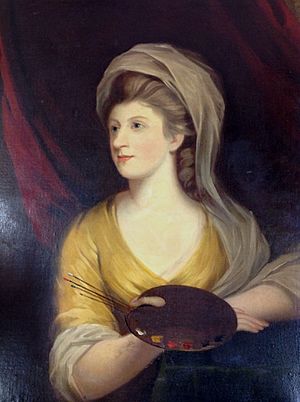Diana Noel, 2nd Baroness Barham facts for kids
Quick facts for kids
Diana Noel
|
|
|---|---|
 |
|
| Baroness Barham | |
| Reign | 17 June 1813-12 April 1823 |
| Predecessor | Charles Middleton, 1st Baron Barham |
| Successor | Charles Noel, 1st Earl of Gainsborough |
| Born | Diana Middleton 18 September 1762 Barham Court, Teston, Kent |
| Died | 12 April 1823 Fairy Hill, Gower |
| Buried | Teston |
| Spouse(s) | Sir Gerard Noel, 2nd Baronet |
| Issue | Charles Noel, 1st Earl of Gainsborough |
| Father | Charles Middleton |
| Mother | Margaret Gambier |
Diana Noel, 2nd Baroness Barham (born September 18, 1762 – died April 12, 1823) was an important woman who helped many people. She was a Baroness, which is a noble title. Diana was also a philanthropist, meaning she loved to help others, and an abolitionist, someone who worked to end slavery. She is remembered for setting up schools and churches in a place called the Gower Peninsula in Wales.
Diana's Early Life and Family
Diana was born on September 18, 1762, at Barham Court in Teston, Kent, England. Her parents were Margaret Gambier and Charles Middleton. Her father was a high-ranking officer in the navy, known as an admiral. He later received the title of Baron Barham in 1805.
Diana's family were Calvinist Methodists, a type of Christian faith. They had many famous friends who shared their beliefs and desire to help others. These friends included Hannah More, a writer and helper of people, George Whitefield, a religious leader, and William Wilberforce, a politician who fought against slavery.
Her Marriage and Family Life
On December 21, 1780, Diana married Gerard Edwardes. He was a banker who had studied at Cambridge University and was also a Member of Parliament, meaning he helped make laws for the country. In 1798, Gerard inherited land and money from his uncle and changed his last name to Noel.
Diana and Gerard had eighteen children! One of their sons, Baptist Wriothesley Noel, described their home as a mix of interesting ideas. He said they had "whig politics" (a political group that wanted more power for Parliament), strong religious beliefs, and a unique, independent way of thinking.
Becoming Baroness Barham and Her Work
When Diana's father passed away in 1813, she became the 2nd Baroness Barham. This happened because she was his only child, and the title was set up to pass to her.
Around this time, Diana decided to move to Fairy Hill in Gower, Wales. She began using her own money to build free schools for children. She also funded the building of several churches, including four Independent churches and two Calvinist Methodist churches.
Diana was also a strong supporter of ending slavery. She was friends with Samuel Johnson, another important figure of her time.
Diana Noel passed away at Fairy Hill on April 12, 1823, and was buried in Teston. Her son, Charles, then became Lord Barham. He made sure the churches his mother built were looked after by trustees. Many of her letters and family records are kept in Leicestershire, England, and photos related to her life are at the Chipping Campden History Society.

